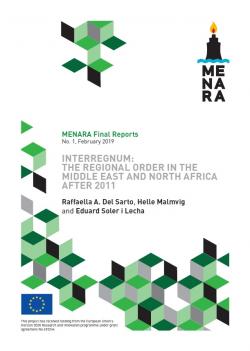Interregnum: The Regional Order in the Middle East and North Africa after 2011
The MENA region has entered a period in which the existing order is increasingly challenged while an alternative one is still to be framed. This report contends that the Middle East regional order since 2011 has changed in several ways. This is evidenced by the decline in US power and Russia’s comeback, the rise of sectarianism, the growing influence of non-state actors, the return of Arab state permeability, intensified rivalry between Iran and Saudi Arabia, the emergence of regional players such as Turkey, Qatar and the United Arab Emirates, the fluidity of alliances and shifting centres of gravity. However, these and other changes constitute a change within the order, rather than of order. The report also argues that the sovereign state system and territorial boundaries are more resilient than widely assumed and that explanations of regional politics based on notions of Sunni–Shia antagonism are overly simplistic and may even lead to dangerous policy prescriptions.
Published also in Arabic, French and Turkish.
-
Details
Rome, IAI, February 2019, 57 p. -
In:
-
Issue
Final Reports 1
Executive Summary
Introduction
1. Regional Order and Change: Conceptual Underpinnings
2. The Domestic-Regional Nexus: The Weakening of States, Heightened Regime Insecurities and Sectarian Securitization
2.1 The Weakening of States and the Growing Role of Non-State Actors
2.1.1 Regional Implications
2.2 Regime Insecurities and Authoritarian Resilience
2.3 Ethno-sectarian Securitization
3. Regional Dynamics: Polarity, Patterns of Amity and Enmity, Alliances and Geopolitical Shifts
3.1 Patterns of Multipolarity: Beyond the Saudi–Iranian Confrontation
3.2 Patterns of Amity and Enmity: Overlapping and Multi-layered Cleavages
3.2.1 The Arab–Israeli Conflict and the Norm of Arab Unity
3.2.2 Sectarian Securitization at a Regional Scale
3.2.3 Change versus Status Quo
3.3 Patterns of Cooperation: Liquid Alliances and the Mirage of Regionalism
3.4 Shifting Centres of Gravity: The Gulf and Africa
4. International Permeation and the Degree of Regional Autonomy
4.1 Independent Foreign Policies and Space of Manoeuvre
4.2 Tail-wags-the-dog Dynamics: Drawing Powers in and the Internalization of Security Perceptions
Summary and Conclusions
References



